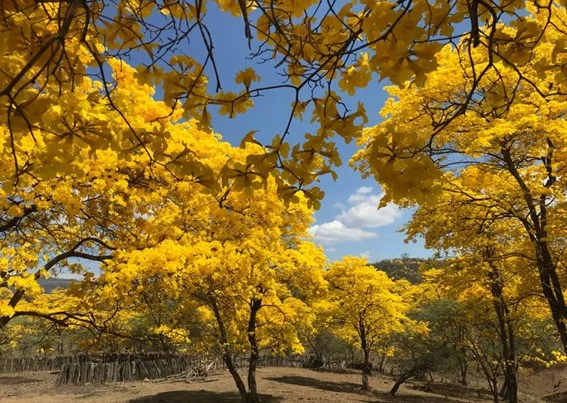
The south of Ecuador dresses in yellow with the flowering of Guayacanes. | Travel Blog
The guayacan is a tree native to tropical America, with a wide distribution in the Caribbean islands (especially Jamaica, Puerto Rico, Cuba and the Dominican Republic), Colombia, Ecuador, Panama, Venezuela and Costa Rica. It is frequently found in low elevations and stony plains, but can also form part of the dry forest up to 500m.
This species can reach a height of 20 meters and is characterized by a dense and leafy canopy that measures about 10 meters. Guayacanes bloom once or twice a year. Generally in the southern zone of Ecuador, the flowering occurs in the months of January or February. As such, this phenomenon is a tourist attraction.
The blooming of the guayacanes, in the province of Loja, south of Ecuador, is a true natural spectacle. During the rainy season, the Guayacanes bloom within a period of 5 to 8 days. At the end of this period, the flowers fall and transform the ground into a yellow carpet.
In addition to being a joyful event, flowering is also of ecological importance, as it represents the pollination season, an invitation for birds such as hummingbirds, wasps, ants and bats to absorb the sweet nectar and convert it into organic matter that can be used to enrich the soil.
Now, we mentioned there are different places where the Guayacanes bloom, but you may wonder which is the best place to see the Guayacanes blooming and what do I need to bring? Below, we present two alternatives to visit and we will give you the best recommendations to make you picture what could become one of the best experiences you might ever have.
You can visit Mangahurco
The flowering of the Guayacanes in Mangahurco, canton Zapotillo usually takes place in January. After the first rains, more than 40,000 hectares are dyed bright yellow. In addition, Mangahurco itself is known for having the largest Guayacan forest in the world, which makes your visit a unique and unforgettable experience. If you are traveling from Loja, take the Catamayo road, which can also be reached from Quito by air. Follow the Catamayo-San Pedro de la Bendita road, towards Vela Cruz-Catacocha. If you leave early you will have time to stop in Catacocha and visit the Chiriculapo viewpoint or walk the streets of this town, Cultural Heritage of Ecuador. Follow the road south to El Empalme, where there is a military checkpoint and from there to the right and Celica. Continue along the Pósul-Pindal road and take the Paletillas road until you reach Mangahurco.
Arenillas Ecological Reserve
The Arenillas Ecological Reserve has 13,170.025 ha of tropical dry forest. It is one of the most important xerophytic remnants of the Ecuadorian coast and also has one of the largest areas of southwestern Ecuador. This reserve is home to a wide range of endemic species, as well as the great spectacle of the flowering of the Guayacanes, in which more than 3 thousand tourists come to appreciate the beautiful yellow mantle of flowers that covers the Reserve.
Take into consideration that the characteristic climate of both Mangahurco and Arenillas Ecological Reserve is hot, with rains that occur frequently during the afternoon and evening. For this reason you need to bring
- Good footwear
- Comfortable clothing such as T-shirts and shorts
- Hat
- Sun block
- Rain poncho
- Water bottle
- Insect repellent
During your visit to this natural event, you can top it up with activities such as horseback riding, hiking through the forest and camping under the trees. In addition, another interesting activity is the tasting of dishes, so Loja offers dishes such as seco de chivo and seco de gallina criolla with yucca.
Finally, here are some suggestions
It is not recommended that you plan your trip around the flowering of the guayacanes, as it depends largely on the weather. It is better to plan your visit to Loja in January and ask your guide to be attentive to the signs of flowering, so that you have the opportunity to live the experience from the beginning to the end of the show.
Undoubtedly this natural event surprises locals and foreigners for the beautiful gift that nature always offers us, it remains as a reflection to take care and protect these destinations that are both scenic and ecological importance.
Check Our Suggested Tours:
